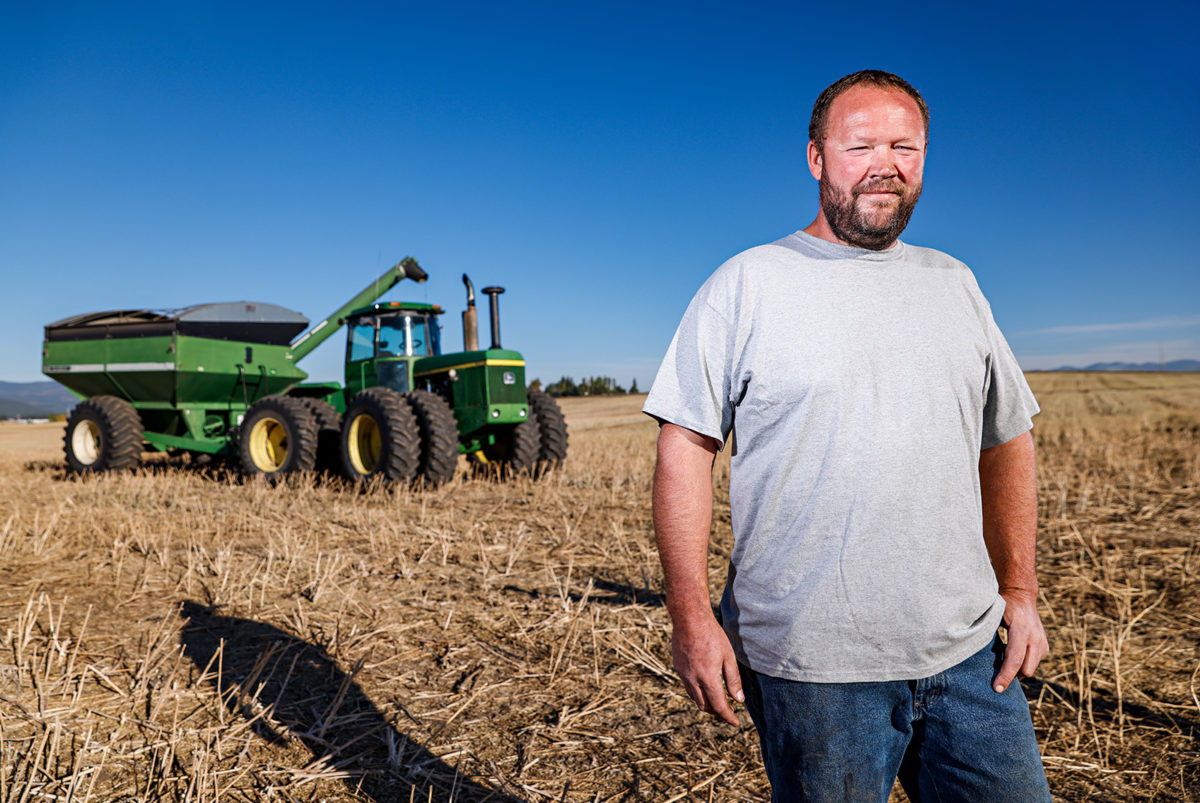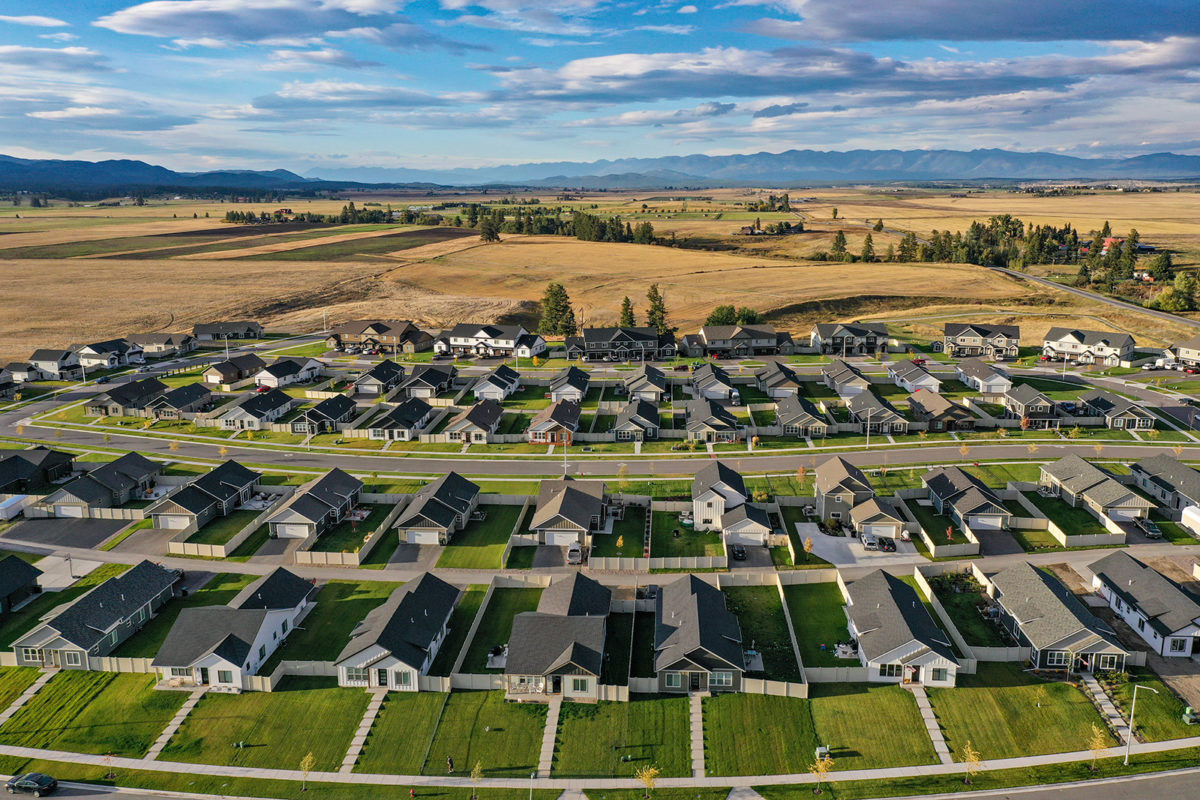Selling the Farm
The agricultural community is shrinking in the Flathead Valley as landowners sell to developers, impacting the farming culture and rural economy
By Maggie Dresser
Born and raised on his family’s farm in West Valley, Derek Krueger grew up driving machinery from age 10, raising pigs and cows and producing hay and grains. After he graduated high school, he started working in concrete construction for his dad in the late 1990s and then left the valley in 2008 to pursue underwater welding in Florida.
After he was diagnosed with colon cancer while he was there, Krueger returned home in 2009, in the midst of the Great Recession, to pick up construction work once again.
“You couldn’t buy a job,” Krueger said. “I bid some jobs at cost and I didn’t get them.”
With development at a standstill, Krueger returned to his roots and rented 100 acres near Airport Road where he started Krueger Farms, growing wheat, canola and hay on a piece of property that was supposed to be slated for development until it was halted by the recession.
“I took it from going into a subdivision and turned it back into agriculture,” Krueger said. “I made a pretty decent living and I kept growing and growing.”
More than a decade later, Krueger, who is now 39, leases about 2,700 acres from various property owners throughout the area, mostly in West Valley. At the peak, he had 3,100 acres, but now he loses about 100 acres per year to developers.
On one of his current leased properties, he farms canola on portions of a 640-acre parcel off of Stillwater Road near Glacier High School, which the City of Kalispell annexed in the late 2000s. To the southeast, crews are moving dirt for apartments, while 20 acres on the east side of the plot will begin development this winter, he said.
“This whole acreage is slated for development,” Krueger said.

But despite Krueger’s emotional attachment to farming and open land, he doesn’t blame property owners for selling. In a good year, Krueger profits $100 per acre compared to land that is now selling for roughly $30,000 per acre.
As new residents move to the Flathead Valley, sending both housing demand and prices skyrocketing, land is increasingly valuable.
Kalispell is already slated to see hundreds of new housing units on the market in the next year, and officials have been planning infrastructure development to accommodate the Flathead’s growth, including wastewater treatment and a sanitary sewer on the city’s west side.
“The thing about land development is it’s kind of a natural byproduct of economic growth,” said Dan Bigelow, an agriculture economics professor at Montana State University. “A lot of people are priced out of the market and increasing the supply of housing through development is the only way to alleviate that pressure.”
On the supply side, developers are taking full advantage of high housing prices, Bigelow says, and are willing to pay more than they otherwise would.
“With the price of land for development and housing prices being so high, landowners are making the decision that now is the time sell,” Bigelow. “But the thing about development is, it’s irreversible.”
Once farmland is developed, it will never be farmland again, erasing the agriculture community from portions of the Flathead Valley forever.
Bigelow says it’s difficult to say what impact this has on the agricultural economy, which depends on what is being produced and if it’s going to national or global markets.
Krueger sells all of his crops to CHS in Kalispell, which relocated to the Glacier Rail Park in 2019 and built a new grain elevator at the rail-served industrial park with funding from the City of Kalispell’s Transportation Investment Generating Economic Recovery (TIGER) grant.
Bigelow says fewer local farms could be a cost to CHS, but he describes it as a transfer of costs.
“They’re losing at the expense of landowners who are gaining,” Bigelow said.
Beyond economic losses, Bigelow says the Flathead is losing its rural, agricultural culture more than anything, as landowners whose family homesteaded their property continue to sell.
In Kalispell’s Lower Valley, Sandy O’Connell’s family homesteaded their property in the 1890s and started producing grain, adding hay production a few decades ago.
As both a farmer and a real estate agent, O’Connell sees a lot of new faces moving in, including quite a few with horses, and now she can’t keep up with hay production.
“I think people want their 5 acres and their horses and they want to live in the country,” O’Connell said. “They’re just living the dream; that’s why they’re moving here.”
While O’Connell doesn’t blame new residents for relocating to the Flathead, she says her number one complaint is the lack of respect for agriculture.
“Everybody is in a huge hurry,” O’Connell said. “The roads are just packed. They’re like a race track.”
O’Connell and her husband move 15 different pieces of farm equipment up and down Lower Valley Road, and she says vehicles don’t move over when they drive by, creating dangerous conditions on roads that once were much quieter.
“My husband is getting to the point where he says, ‘I don’t know if I can keep doing this,’” O’Connell said. “I’m driving expensive equipment down the road, they tailgate you, it’s just rude and our roads weren’t designed for all this traffic in Lower Valley.”

This spring, a woman wound up in a ditch while she was driving a brand new Ford Bronco, nearly hitting Krueger as he drove a sprayer down Farm to Market Road while she passed him going 20 miles per hour over the speed limit.
“A new sprayer is $200,000,” Krueger said. “If she had hit me at 70, I would have rolled and it would have been totaled.”
“The traffic is the most impactful,” Krueger added. “But the land sales are right up there. It’s a problem if they want us to keep agriculture in Flathead County … It was much easier six or seven years ago, but since COVID hit, it’s really picked up. Before that it was busy, but now it’s a nightmare.”
Farmers in the Flathead view development as inevitable, despite their love for agriculture and open space.
Some landowners donate their land for conservation easements, where they give up certain property rights in exchange for a tax break and land-use protections. But the tax break doesn’t come close to the market value and is appraised at different values depending on its purpose. Development appraisal, for example, would be much higher than agricultural appraisal for the same parcel of land, says Bigelow, the professor at MSU.
At Flathead Land Trust, Land Protection Specialist Ryan Hunter says while conservation easements offer a tax incentive, they can’t compete with developers. Some landowners would prefer to sell to developers for financial reasons, but others are passionate about farmland and don’t want to see their family’s property turned into a subdivision.
“Typically farmers who have been in the valley for a long time and families who homesteaded the farms and have been here for generations, it’s difficult for many to see the loss of farmland and see changes in the valley,” Hunter said.

There have been significant conservation easements on farmland over the years, including the Louden family placing conservation easements on more than 1,000 acres of land roughly a decade ago and the Grosswiler and Marvin families who placed 400 acres in a conservation easement near Kalispell in 2018.
“The conservation easements are going to help,” Krueger said. “But someone has to foot the bill between selling the land and putting it into conservation. That amount of money has to be laid up somewhere, otherwise who is going to do it?”
While the easements help preserve some farmland, Krueger isn’t sure if there’s enough interest to make a significant difference.
Even though Krueger could make more money in construction, he says he’ll continue farming for the foreseeable future, even as his farming acreage shrinks and subdivisions and hobby farms continue to proliferate across the landscape.
“The agricultural community will have to shrink to what the farmland can support,” Krueger said.